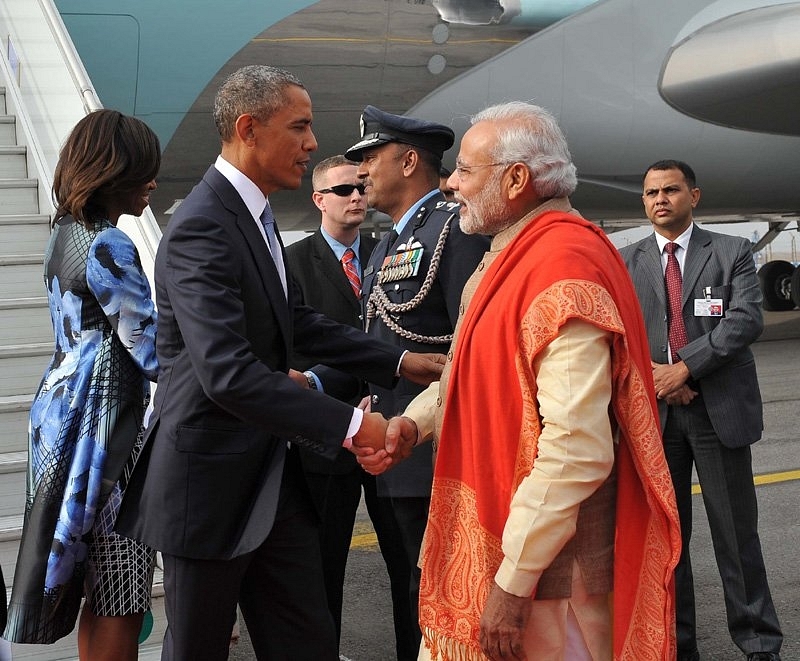Politics
Is Anything Different This Time?

As you read this, US president Barack Obama has landed in Delhi to attend the Republic Day celebrations. This is not his first trip – he visited India previously in 2010 and this, his second trip, makes him the only sitting POTUS to visit the country twice. Litres of ink have been spilled on articles about this visit, as was the case during his last visit, Prime Minister Narendra Modi’s visit to the United States in September, and every senior delegation from the United States to India over the past five years.
Unfortunately, these meetings have been unable to provide any major breakthroughs on the issues that find the two countries at loggerheads. To be fair, progress has been made, but only in inches while new differences – such as the infamous Devyani Khobragade case – have been significant. However, such is the nature of India-US relations – despite little by way of tangible measures to show for their ‘strategic relationship,’ ties between the two countries remain fuelled by emotion and hope in the enormous potential of finding the right frequency.
There was little reason to write new op-eds for this visit – recycling any old one would have done just as well. During this trip, one is most likely to hear the same buzzwords being mentioned: nuclear suppliers’ liability, defence manufacturing, weapons sales, access to technology, cooperation in counter-terrorism, climate change, economic reforms, time to sweat the little stuff, strategic partnership, importance of symbolism. The denial of a US visa to Modi in 2005 will also find the obligatory mention.
There is nothing wrong with this menu – indeed, these are many of the issues that vex lawyers and lawmakers in India and the United States. Yet it is this same menu that has been brought out at every state visit. Years of hoping for an administrative alignment that would deliver on the breakthroughs achieved during the Bush administration leaves one resigned to the bureaucratic stagnation that has been the flavour of India-US relations ever since the agreement on civil nuclear cooperation.
Is anything different this time? Perhaps. A new government has come to power in Delhi, one that holds a single-party majority in the Lok Sabha. The last time this happened was in 1984. This gives hope that any bold decisions that have to be taken will meet with less resistance and avoid the perilous scrutiny of coalition politics. Furthermore, Modi has surprised his supporters and detractors alike on being quick to embrace the United States and its president despite the common Indian perception of a White House lukewarm towards India. On all other fronts, including the much vaunted American pivot to Asia, there is little change.
There have been some rumblings about the United States setting up a manufacturing plant for one of its unmanned aerial vehicles, the RQ-11 Raven, in Bangalore. There has also been talk of the establishment of a nuclear insurance pool for suppliers, enabling them to skirt the liability they would face as per present Indian law. It is hoped – that magic word again – that the Raven manufacturing facility will be the first of many but several hurdles are yet to be crossed – land acquisition, licenses – and processes streamlined if such investments are to become common. To this end, a somewhat unrelated but constructive step is the acceptance of a few key protocols such as the Communications and Information Security Memorandum of Agreement (CISMOA) and the Logistics Support Agreement (LSA). Reports that the Modi government is considering this is heartening for it would pave the way for enhanced military cooperation between India and the United States as well as contribute to the building of trust between the two countries.
It should be noted, however, that such trickling of cooperation has always preceded or followed a state visit. India has bought increasingly sophisticated arms and recently the anti-tank guided missile FGM-148 Javelin was also offered to India after initial hesitation. Obama’s trip also carries such trinkets but sustained and institutionalised betterment of relations may yet be a bridge too far. This is disappointing, given that relations between Washington and Delhi have been generally on the upswing for the past 17 years. After a low point in the immediate aftermath of the Pokhran II nuclear tests, the Jaswant Singh – Strobe Talbott channel paved the way for a constructive dialogue between Delhi and Washington. The nuclear agreement in announced in July 2005 came on the heels of this groundwork and several smaller measures during the Vajpayee government.
It would be nice to see some positive developments that establish India-US cooperation on a firmer institutional setting during Obama’s current visit. If Hope lived in Pandora’s box amidst all sorts of nuisance and evil, surely we can also hope and reread the old op-eds on India-US relations until things actually begin to change.
Introducing ElectionsHQ + 50 Ground Reports Project
The 2024 elections might seem easy to guess, but there are some important questions that shouldn't be missed.
Do freebies still sway voters? Do people prioritise infrastructure when voting? How will Punjab vote?
The answers to these questions provide great insights into where we, as a country, are headed in the years to come.
Swarajya is starting a project with an aim to do 50 solid ground stories and a smart commentary service on WhatsApp, a one-of-a-kind. We'd love your support during this election season.
Click below to contribute.
Latest